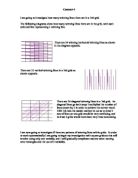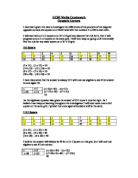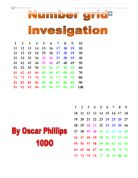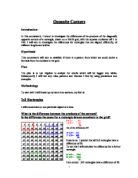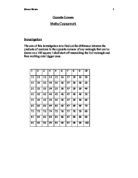Maths coursework- stair totals. I shall be investigating the total and difference in sets of stairs in different grid sizes. I will be investigating the relationship between stair totals on different grids.
GCSE Mathematics Coursework Introduction In my mathematics GCSE coursework I shall be investigating the total and difference in sets of stairs in different grid sizes. I will be investigating the relationship between stair totals on different grids. This will also include different stair sizes. I will choose to display my findings using a mixture of graphs, tables and grids. I shall also try to work out the formula for each of the number of step sizes. After I have finished investigating the different sized number stairs I will attempt to find out the different sized number grids. At the end of my investigation I will conclude by demonstrating and explaining the relationship between all sizes of stairs. Method I shall be carrying out my stair challenge by finding out the correct information. I shall do this by experimenting with the size of the grid corresponding to the size of the stairs used in the grid. I shall try to work out the formulas by recognising any similarities in the results obtained. Part 1- Three Step grid I have investigated the three step stair (some of my findings can be viewed on the graph paper in the back). During my investigation I believe that I have worked out the formula for the total inside the three step stairs on a 10 x 10 grid. Below is an example of just one of the three sets of stairs that I used to conduct my
Number Grid Aim: The aim of this investigation is to formulate an algebraic equation that works out the product of multiplying diagonally opposite corners of a particular shape and finding the difference between the results
Mathematics Coursework Number Grid Aim: The aim of this investigation is to formulate an algebraic equation that works out the product of multiplying diagonally opposite corners of a particular shape and finding the difference between the results. I will start off by working this out on a 2x2 square in a 10 x 10 grid and then will investigate varying the widths and lengths of squares and rectangles. Method: In order to simplify the process, the investigation has been divided into sections according to the size of squares in the grids. 2 x 2 Squares To begin with, I used a 10 x 10 grid, looking at 2 x 2 squares: 2 3 4 5 6 7 8 9 0 1 2 3 4 5 6 7 8 9 20 21 22 23 24 25 26 27 28 29 30 31 32 33 34 35 36 37 38 39 40 41 42 43 44 45 46 47 48 49 50 51 52 53 54 55 56 57 58 59 60 61 62 63 64 65 66 67 68 69 70 71 72 73 74 75 76 77 78 79 80 81 82 83 84 85 86 87 88 89 90 91 92 93 94 95 96 97 98 99 00 Then I took 2 x 2 squares from this grid and multiplied the opposing corners to calculate the difference between the two products. 2 1 2 x 12 = 12 2 x 11 = 22 ? 22 - 12 = 10 So the difference between the answers is 10. I then took another 2 x 2 box from the above 10 x 10 grid: 47 48 57 58 47 x 58 = 2726 48 x 57 = 2736 ? 2736- 2726 = 10 The difference is 10 again. Perhaps this
Opposite Corners of a Square on a Number Grid
Number Grid - Opposite Corners Investigation Introduction: This task involves pupils investigating the relationship between the results, when diagonally opposite numbers in various sizes of squares are multiplied, and comparing the products. Number Grid - Opposite Corners Investigation Method: . I will use a number grid from 1-100, like the one below, to collect examples of data from different size squares. 2. I will show 4 examples of each size of squares, to confirm each of the differences at the different stages. 3. I will look for a pattern and, if I find one, will explain it fully. 4. I will make a prediction of what I think will happen next and see if it works. 5. I will create an algebraic expression to prove my results. 6. I will then test my algebraic expression on the diagonally opposite corners a rectangle, to see if that works as well. 7. I will then describe the sequence and relationship of the results. 8. I will present my results in a table and write a conclusion. Prediction: I predict that there will be a relevant relationship between the size of the box and the difference in results of the opposite corners. I think there will be a pattern, and an algebraic expression, which will work for all the box sizes. I think this investigation will be one in which you could branch off into many different sections. I think there will be a lot to explore and
I am going to investigate taking a square of numbers from a grid, multiplying the opposite corners and finding the difference of these two results. To start I used a 5x5 grid:
Maths Coursework Number Grids I am going to investigate taking a square of numbers from a grid, multiplying the opposite corners and finding the difference of these two results. To start I used a 5x5 grid: 2 3 4 5 6 7 8 9 0 1 2 3 4 5 6 7 8 9 20 21 22 23 24 25 Then I took 2x2 squares out of this grid and multiplied the opposite corners, to find the difference: 2 6 7 x 7 = 7 2 x 6 = 12 2 - 7 = 5 So the difference between the answers is 5. Next I took another 2x2 square from the same grid. 9 20 24 25 9 x 25 = 475 20 x 24 = 480 480 - 475 = 5 The difference is 5 again. I thought this could mean that all 2x2 squares in a 5x5 grid would come out with a difference of 5. To check this, I took another 2x2 square out of the grid to check. 2 3 7 8 2 x 18 = 216 3 x 17 = 221 221 - 216 = 5 So this shows that my prediction was right and every 2x2 square in a 5x5 grid should come out with a difference of 5. Any 2x2 square in a 5x5 grid = Difference of 5 Now I am going to start taking 2x2 squares out of a 6x6 grid. 2 7 8 x 8 = 8 2 x 7 = 14 4 - 8 = 6 The difference is 6. 21 22 27 28 21 x 28 = 588 22 x 27 = 594 594 - 588 = 6 Again the difference is 6. So I can see like in the 5x5 grid there is a pattern. If I am right every 2x2 square in a 6x6 grid should have a difference of 6. To check if I am right I will take one more square
To find a relationship between the opposite corners in various shapes and sizes.
Gemma McCormick Opposite Corners Aim: - To find a relationship between the opposite corners in various shapes and sizes. First I am going to draw a square that will be 10 squares in depth and 10 squares in width. I am the going to number the squares 1 to 100, 1 in the top corner and 100 in the bottom square. I will then draw a series of two by two squares inside my main grid. The aim being to find out a relationship between the opposite corners inside the small boxes. Ten by Ten (2x2) 2 3 4 5 6 7 8 9 0 1 2 3 4 5 6 7 8 9 20 21 22 23 24 25 26 27 28 29 30 31 32 33 34 35 36 37 38 39 40 41 42 43 44 45 46 47 48 49 50 51 52 53 54 55 56 57 58 59 60 61 62 63 64 65 66 67 68 69 70 71 72 73 74 75 76 77 78 79 80 81 82 83 84 85 86 87 88 89 90 91 92 93 94 95 96 97 98 99 00 I am now going to multiply the opposite corners in each box (Note the boxes are highlighted in red) Box 1 4 x 25 = 350 5 x 24 = 360 I am now going to look at the difference in each corner by subtracting my two answers. 350 - 360 = 10 The difference between the opposite corners was ten; I am now going to see if this is repeated. To do this I will repeat the process until my results show a constant pattern. 56 x 67 = 3752 57 x 66 = 3752 3762 - 3752 = 10 The difference again is 10, this would lead me to believe
Opposite Corners Maths investigation.
Opposite Corners Maths investigation Introduction For this investigation I am going to try and develop a formula to work out the difference between the products of the numbers in the opposite corners of any rectangle that can be drawn on a 10 x 10 grid composing of 100 squares. I shall use tables to present my findings; I shall be making predictions and proving my predictions right or wrong with examples. I will be using algebra to prove any of the rules I manage to create by analysing my results. Method To begin with I shall first find the difference between the products of the numbers in the opposite corners of 2x3 rectangles. . 34 x 26 = 884 24 x 36 = 864 20 Do all 2x3 rectangles have a difference of 20? 2. 58 x 50 = 2990 48 x 60 = 2880 20 It appears that they do. I predict that all 2x3 rectangles have a difference of 20. To prove this I shall calculate the difference between the products of the number in the opposite corners of one more 3x2 rectangle. 3. 85 x 77 = 6545 75 x 87 = 6525 20 Yes, it appears my prediction is correct. All 2x3 rectangles on the grid have a difference of 20. However what if the rectangle is aligned differently on the grid, so the shorted sides are at the top and bottom? Will the difference for that still be 20? . 46 x 65 = 2990 45 x 66 = 2970 20 Nope, it is still 20. I will now try rectangles with the same height of two,
My course work in maths is going to consist of opposite corners and/or hidden faces.
My course work in maths is going to consist of opposite corners and/or hidden faces. For my first course in mathematics I have been given the task of investigating the difference between the products of the numbers in the opposite corners of my rectangle that can be drawn on a 10 by 10 square. I will start off by showing some examples of different rectangles and what the sum of the corners will be. This will help me to determine whether or not there is a pattern. Example 2 3 4 5 6 7 8 9 0 1 2 3 4 5 6 7 8 9 20 21 22 23 24 25 26 27 28 29 30 31 32 33 34 35 36 37 38 39 40 41 42 43 44 45 46 47 48 49 50 51 52 53 54 55 56 57 58 59 60 61 62 63 64 65 66 67 68 69 70 71 72 73 74 75 76 77 78 79 80 81 82 83 84 85 86 87 88 89 90 91 92 93 94 95 96 97 98 99 00 1* 12=12 2* 11=22 22-12=10 This example shows us that between the squares 1,2,11,12 the sum will be 10. We will now go on to see what a square between 1,2,21,22 will be. Example 2 3 4 5 6 7 8 9 0 1 2 3 4 5 6 7 8 9 20 21 22 23 24 25 26 27 28 29 30 31 32 33 34 35 36 37 38 39 40 41 42 43 44 45 46 47 48 49 50 51 52 53 54 55 56 57 58 59 60 61 62 63 64 65 66 67 68 69 70 71 72 73 74 75 76 77 78 79 80 81 82 83 84 85 86 87 88 89 90 91 92 93 94 95
Opposite Corners.
Opposite Corners Investigation: Given a 100 Square, I am to investigate the difference between the products of the numbers in the opposite corners of any rectangle that can be drawn on the 100 square. 2 3 4 5 6 7 8 9 0 1 2 3 4 5 6 7 8 9 20 21 22 23 24 25 26 27 28 29 30 31 32 33 34 35 36 37 38 39 40 41 42 43 44 45 46 47 48 49 50 51 52 53 54 55 56 57 58 59 60 61 62 63 64 65 66 67 68 69 70 71 72 73 74 75 76 77 78 79 80 81 82 83 84 85 86 87 88 89 90 91 92 93 94 95 96 97 98 99 00 2x3 A rectangle has been highlighted in the 100 square 1 and 13/11 and 3 are the numbers in the opposite corners product of the number in these opposite corners are x13=13 1x3=33 The difference between these products is 33-13= 20 A rectangle has been highlighted in the 100 square 4 and 16/14 and 6 are the numbers in the opposite corners product of the number in these opposite corners are 4x16=64 4x6=84 The difference between these products is 84-64= 20 A rectangle has been highlighted in the 100 square 7 and 19/17 and 9 are the numbers in the opposite corners product of the number in these opposite corners are 7x19=133 7x9=153 The difference between these products is 153-133=20 Conclusion: I have Concluded that my prediction was correct and that a 2 by 3 rectangles have a
Opposite Corners
Louis Franks 10PC 10X2 10/12/01 Opposite Corners Wx L Difference Increase Wx L Difference Increase 2 x 3 20 0 6 x 3 00 50 2 x 4 30 0 6 x 4 50 50 2 x 5 40 0 6 x 5 200 50 2 x 6 50 0 6 x 6 250 50 2 x 7 60 0 6 x 7 300 50 2 x 8 70 0 6 x 8 350 50 2 x 9 80 0 6 x 9 400 50 2 x 10 90 0 6 x 10 450 50 We are investigating the difference between the products of the numbers in the opposite corners of any rectangles that can be put on a 100 square. 2 x 3 Rectangles 2 3 1 2 3 To keep things simple I have started with rectangles with a width of 2 squares. I kept the width to two squares and increased the length by one square. (see results table above). I discovered that the width increases by 10 every time the length increases by 1. The difference can be worked out for all rectangles with a width of 2 squares by using several formulas: . (Length - 1 x 10 = Z) 3 - 1x 10 = 20 = Z Then (Width x Z ) - Z = difference of opposite corners 2 x 20 - 20 = 20 OR 2. L = Length, W = Width (L - 1) (10 (W-1)) = difference of opposite corners Example: (3 - 1) x (10 (2 - 1)) = 20 OR 3. 2 3 1 2 3 Using algebra and going on the theory that the width increases by 10 when the length is increased by 1, I have
investigate how many winning lines there are in a 7x9 grid.
I am going to investigate how many winning lines there are in a 7x9 grid. The following diagrams show how many winning lines there are in the grid, with each coloured line representing 1 winning line. There are 24 winning horizontal winning lines as shown in the diagram opposite. There are 21 vertical winning lines in a 7x6 grid as shown opposite. There are 24 diagonal winning lines in a 7x6 grid. As diagonal lines go both ways I multiplied the number of lines shown by 2 in order to achieve the correct result. I felt this was the easiest method to use as to draw 2 sets of lines on one grid would be very confusing, and to draw 2 grids would have been very time consuming. I am now going to investigate if there are patterns of winning lines within grids. In order to work systematically I am going to begin my investigation with square grids as this will involve using only one variable, and I will gradually complicate matters when moving onto rectangles and the use of 2 variables. Square Grids I am now going to investigate winning lines in square grids. I am going to put my results in a table to enable me to spot any patterns that occur. Winning Lines n (grid size) Horizontal Vertical Diagonal 4 4 4 2 5 0 0 8 6 8 8 8 As we can see horizontal and vertical winning lines are the same in square grids. Horizontal and Vertical Rules The first difference is












